Hopefully your child will not experience at first hand the impact of war. But sadly, many children in our world are living in conflict situations or trying to escape from them. Your child may encounter new arrivals at their school or in their neighbourhood who are survivors, seeking safety and a new life. The reception asylum seekers and refugees receive varies and is not always positive. Stories can be the ideal vehicle for children to begin to develop some insight into the experiences of individuals escaping from conflict situations, and empathy for their plight. Despite the theme these books all contain threads of hope and indicate the power of kindness.
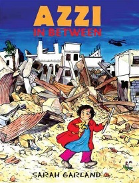 Azzi in Between
Azzi in Between
Sarah Garland
Lincoln Books
Age 5-9
When war comes Azzi and her family have to leave their home. After a dangerous journey they arrive in a strange land Azzi has to learn a new language, cope with different foods, and manage without her beloved grandmother. Told in comic book style this book gives insight into the dislocating experience of leaving your home suddenly and arriving in a strange place. It shows the impact support from the state or individuals and kindness from friends can have. There is hope in the story and fresh beginnings represented by the bag of beans Azzi’s father brings with him.
After sharing the story your child might like to plant some beans like Azzi does and watch them grow or make spicy beans
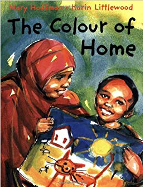 The Colour of Home
The Colour of Home
Mary Hoffman, illus. Karin Littlewood
Frances Lincoln
Age 5-7
Hassan has just arrived in the UK from Somalia and at school everything is strange. When given paints and paper he paints a picture of home, expressing both the happiness of his memories of home but also how the dramatic effects of war changed his world forever. With the help of a translator and a sympathetic teacher he is able to communicate his experiences. Gradually, he settles into his new life and his grey home fills once more with colour.
After sharing this story children might like to paint their own picture of home, showing what it means to them.
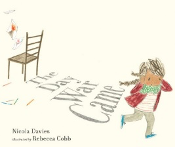 The Day the War Came
The Day the War Came
Nicola Davies, illus. Rebecca Cobb
Walker BooksAge
Age 7-9
Life was peaceful for the little girl in this story but then war came and took everything. War is portrayed as a menacing dark cloud of grey smoke or a pile of rubble where her home had once been. After a long journey seeking asylum nowhere feels safe, war is everywhere it has even seeped inside her. The people she meets are unwelcoming, even the school she hopes to enter turns her away, there is no chair for her. Fortunately, it is other children who make a difference – symbolising their welcome by bringing a chair for every child in need of one.
This story was originally a poem written By Nicola Davies in response to the UK’s refusal to give sanctuary to 3000 unaccompanied children in 2016 and published in the Guardian newspaper. It has been made here into a moving picture book with sensitive yet powerful illustrations by Rebecca Cobb who talks about the book here.
After sharing this story children could design a chair for a new arrival in their class and think about what else they might need too – for example their own tray, pencil, exercise book and peg.
 The Journey
The Journey
Francesca Sanna
Flying Eye
Age 7-9+
A young family are living a happy life in a city near the sea when war strikes. The children’s father is killed and their mother makes the difficult decision to leave to escape the war and find a safe place to live. Their journey is long and dangerous and unresolved; they have not reached their destination at the end of the book. But there is hope that one day, like migrating birds, they will find a safe new home again.
This prizewinning picture book is a powerful combination of word and image. The threat of war is portrayed as a black monster whose hands stretch across the page. The story is narrated by one of the children who feel secure despite their plight with their mother who only reveals her own fears in secret tears shed at night.
After sharing this story children might like to paint a picture of migrating birds similar to the one on the last pages of the book on a long piece of wallpaper lining paper.
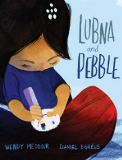 Lubna and the Pebble
Lubna and the Pebble
Wendy Meddour, illus. Daniel Ignéus
OUP Oxford
Age 5-7
Lubna and her daddy are fleeing war, they arrive at night to a world full of tents. Lubna misses her home and her brothers. On the beach she finds a pebble and draws a happy face on it. It becomes her confidante and a great comfort to her. When a sad lonely boy called Amir arrives Lubna finds a playmate. But what will happen to Amir when Lubna and her father are offered a new home and leave the refugee camp? Lubna thinks hard and finds a solution and her pebble a new owner; someone who needs it more than she does.
A simple and beautifully told story with moving illustrations which shows how small sacrifices and gestures of friendship can make a big difference. Sharing the story may lead to lots of discussion, including where Lubna’s brothers and mother might be and why a pebble might become so important when you have nothing.
Children may like to find their own pebble and draw a happy face on it, make a cosy nest for it like Lubna does and perhaps find a new friend to give it to.
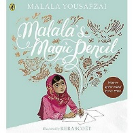 Malala’s Magic Pencil
Malala’s Magic Pencil
Malala Yousafzai, Kerascoët
Puffin
Age 9+
In this picture book Malala tells her own story. She describes her life in Pakistan, her love for her family and what she would draw for them if she had a magic pencil. Her passion for education, for girls as well as boys inspired by her father’s work and her observations of disadvantage in her country is clear. When girls’ rights are restricted by the Taliban Malala speaks out and her resistance makes her a target. Although her attempted assassination is suggested and not described graphically and the book ends on a powerful note of hope for the future this is a book most suited for sharing with older children who could discuss the powerful themes of women’s rights, persecution and resistance. The back of the book contains a further message from Malala and information about her work.
What would your child draw if they had a magic pencil? Perhaps they might choose to make a gift for their family or to something to make the world a better place? Talk about this together.
Malala introduces her book here:
/div>
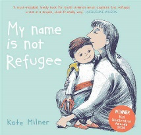 My Name is not Refugee
My Name is not Refugee
Kate Milner
The Bucket List
Age 5-7
In this picture book a mother is talking to her child, preparing him for the journey they will soon have to make to escape danger. We find out that at times it may be interesting or exciting with new things to see, but it will also be long and tiring, strange and worrying and sometimes maybe quite boring. The illustrations reveal the feelings of her young son as we travel with him on his long journey.
Designed to share with an adult, this story explains many aspects of the refugee experience from what it might feel like to leave your home, deciding what to take with you to trying to settle into a new home. There are questions on every page to discuss with your child. What would you take if you had to suddenly leave your home? How far do you think you could walk? What games can you make up when you are bored and have no toys?
 Rose Blanche
Rose Blanche
Ian McEwan, illus. Roberto Innocenti,
Red Fox
Age 9+
Unlike the other books listed here which reflect contemporary experiences this is a historical novel. It relates the experiences of Rose Blanche, a young German girl during the second world war. The effects of the war on her life are slight at first, but the impact deepens as time passes and her awareness of what is going on in her town increases, most dramatically the imprisonment of sad and hungry (obviously Jewish) children behind a barbed wire fence. She seeks to help them and in doing so puts herself in danger. This is a moving story with powerful illustrations providing an enlightening and moving perspective on the possible experiences of children in wartime Germany.
Your child might like to make an imaginary thank you card from a Jewish child who survives imprisonment during the war to Rose Blanche for bringing food and kindness.
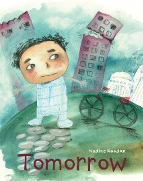 Tomorrow
Tomorrow
Nadine Kaadan
Lantana Publishing
Age 5-7
Beautifully illustrated with colour used to great effect and sensitively written too, this picture book shows how living in a war zone can affect children’s lives. It also demonstrates how in even the most difficult situations there are ways to find pleasure and look forward to a better ‘tomorrow’.
At the back of the book Nadine Kaadan speaks of her aims and describes how her own firsthand experiences in Syria led her to create this book.
Talk together about what you might do if unable to go out for several days at a time or even longer. And what you would miss doing outside. Yazan designs a wonderful park with his mother. You could draw or paint an imaginary park together or perhaps make one from a construction kit or junk.
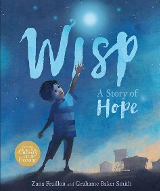 Wisp – a story of hope
Wisp – a story of hope
Zana Fraillon, illus. Grahame Baker Smith
Orchard Books
Age 7-9
Idris’s world is small and bleak. He lives in a refugee camp, ‘a world full of people where everyone was alone.’ One day something magical happens when a wisp of light appeared seeking an old man and giving him back his memories. Many more wisps arrived rekindling memories and happiness for the refugees, giving them back their ‘once’. But how can a wisp of light trigger memories for Idris who has only known the camp? Maybe it can’t but it can bring the promise of a brighter future.
A lyrical and beautifully illustrated story with a message about the power of memory and the importance of hope, recognising all we have been and what we might become.
Talk together about your special memories. Children could ask older members of the family, such as grandparents about their special memories too. Perhaps you could make a recording of these or a scrapbook, with a page for each memory.

 Follow lovemybooksUK15
Follow lovemybooksUK15